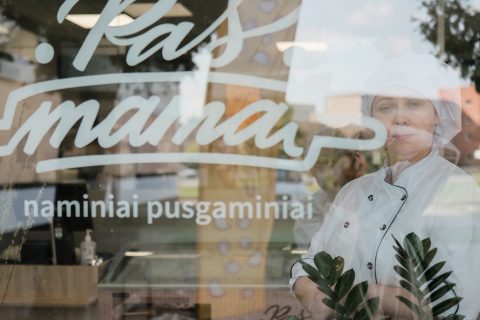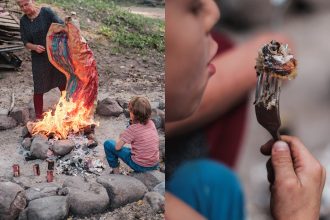I will begin the article with a fragrant flower bomb recipe. You will need clay, flower seeds and soil. Mix the ingredients, form a ball. Go for a walk around the city and when you find a green lawn or an abandoned patch of land, throw the ball there. In just a few weeks you will be able to enjoy a miniature flower meadow. Liz Christy, an artist and pioneer of urban gardening, began to throw similar flower bombs in New York in the 1980s to combat urban stagnation and the concrete jungle that was swallowing more and more of the green spaces.
It is now the year of 2023. The cities in Lithuania are growing, and parks and green spaces are being nurtured, but throwing flower bombs is still advised only for other reasons. Urban beekeeper and founder of Urbanbee.lt Paulius Chockevičius assures that it is a way to contribute to the solution of the issue of our times – the decline of the bee population.
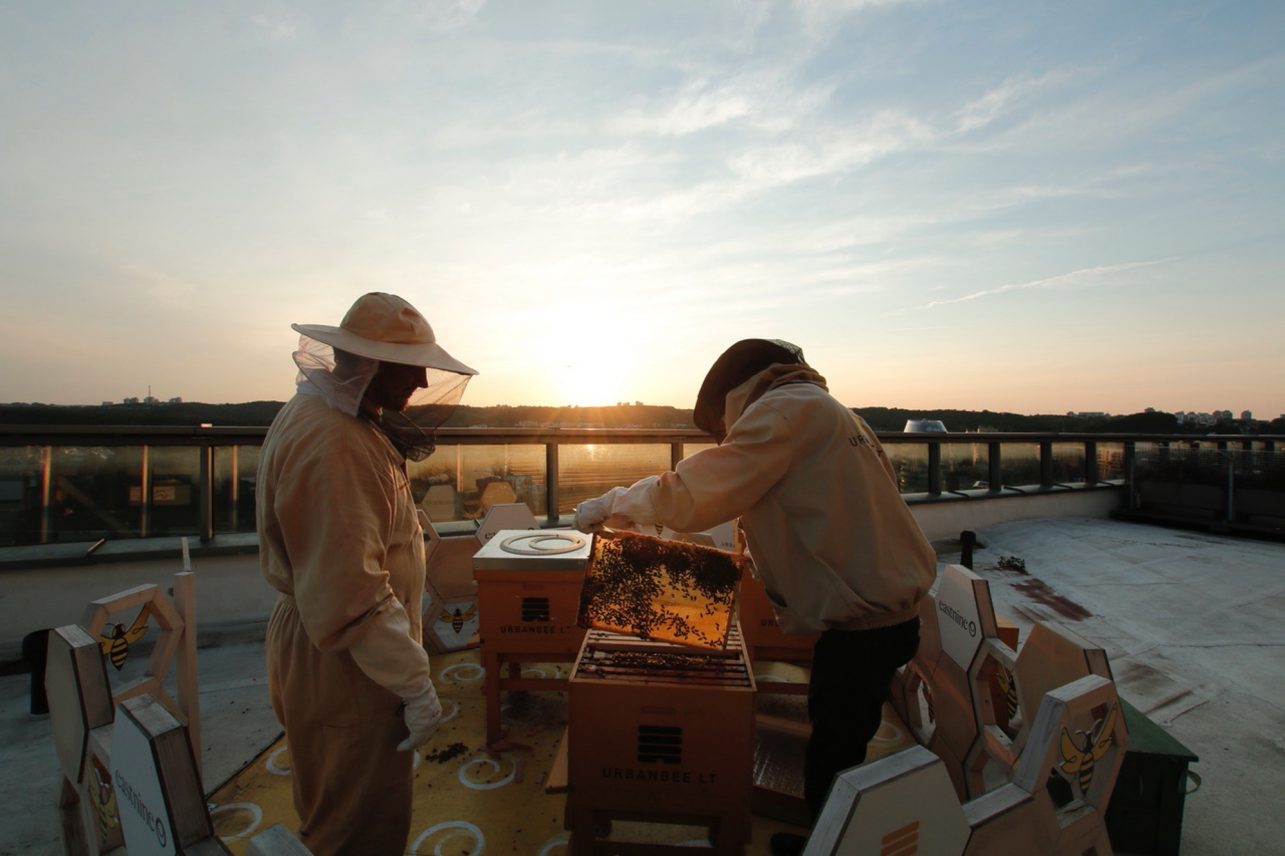
As you open Urbanbee.lt, you are welcomed by Albert Einstein’s quote, stating that if bees disappeared, humanity would only last for four more years. During the conversation, Paulius considered that maybe it wouldn’t take that much, two years would be enough. The Urbanbee.lt team contributes a lot to prevent this scenario from coming true. They are urban beekeepers who have placed beehives in a rather unusual environment – on the rooftops of the city’s buildings. Paulius and the team have combined this traditional craft with knowledge of environmental protection, business, and innovation. They not only house and take care of bees but also collect honey and provide consultations, organize tastings, sell honey and other bee products, conduct educational workshops, and even teach others of this craft.
How and when did bees fly into the life of Urbanbee.lt founder Paulius’ life? The man says that he became interested in beekeeping a long time ago, as a child, but he turned to this activity much later, in 2014, while working in the financial sector in London. In this city, as in a dozen other megacities, urban beekeeping was already strongly developed. Paulius studied beekeeping in London, later in Warsaw and in Lithuanian bee farms. Urbanbee.lt began operating in Lithuania in 2019, when the first beehives were placed on the roof of Babilonas hotel. Now they can be found not only in various places in Kaunas, but also in Vilnius, Riga, and other cities. It is true that Kaunas leads when it comes to unexpected locations. Bee hives in Kaunas can be found even on the rooftop of the Žalgiris Arena swimming pool. It is also interesting that the bees were placed there during the Magenta landscape design festival in 2022 in the hives created by Japanese Kazuhiro Yajima. They were inspired by the icons of modernist architecture in Kaunas: Christ’s Resurrection Church, Kaunas Central Post Office and the KTU Central Administration Building. Next time you pass by, don’t forget to look around: the hives are perfectly visible to passers-by.
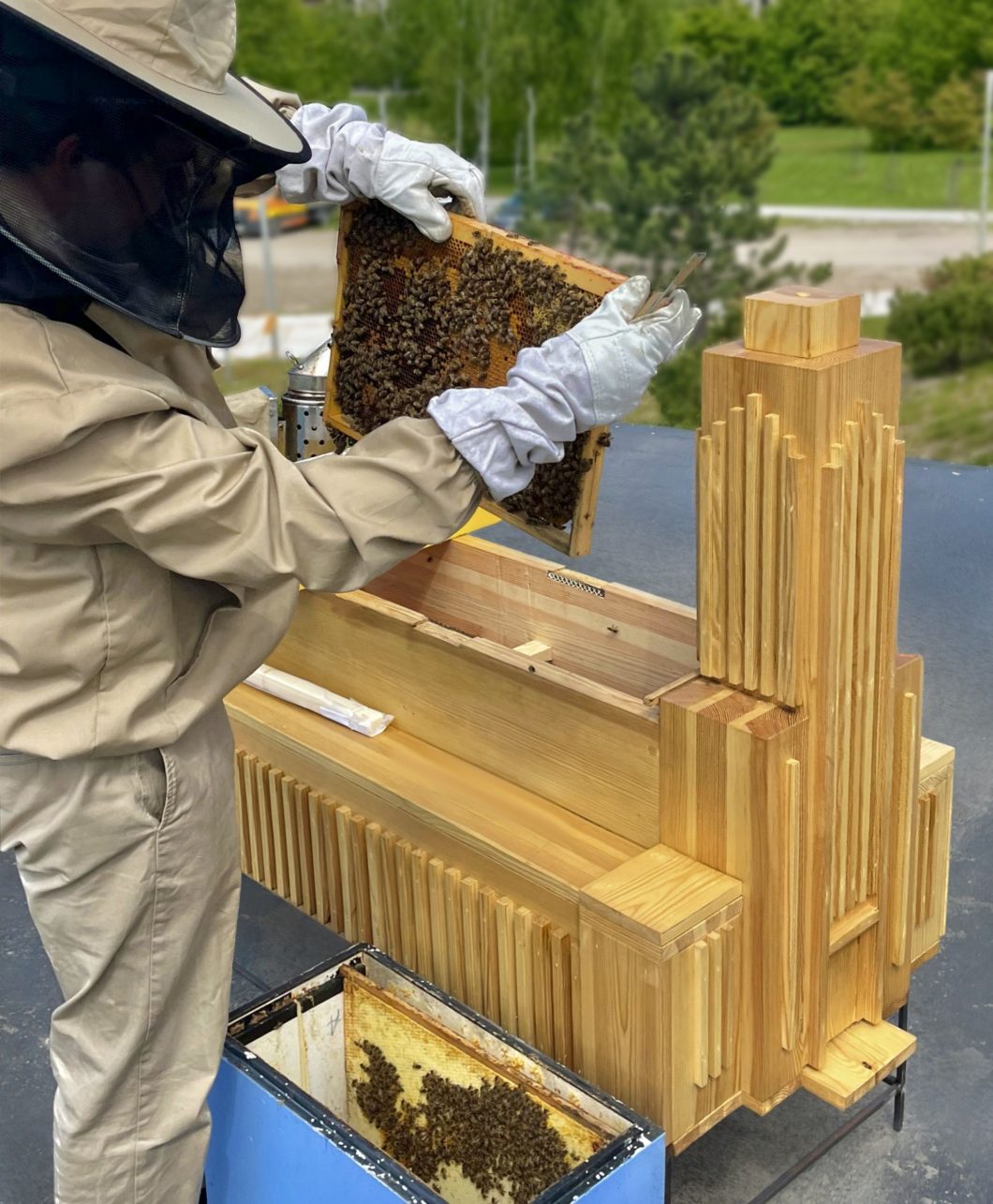
Paulius does not hide that at the beginning, the activities of Urbanbee.lt were met with scepticism – after all, we usually imagine beekeeping in an idyllic village near colourful beehives, with a grey-haired old man tending to the bees. However, the first hives were in trees, and beekeepers were collecting it. The hives were lowered to the ground for the convenience of the beekeepers themselves. Urban beekeepers had to destroy other myths, too. For example, the one that bees are aggressive, that the honey collected in the city is contaminated, and that the bees themselves cannot survive in the city. “Honey collected in cities is sent to certified laboratories abroad, it is tested for heavy metals and pesticides. Qualitative indicators are high. A lot of pesticides are used in rural fields, so the honey collected there is not necessarily better. By the way, people appreciate city honey, because by consuming it, they can get pollen from their environment, thus getting the body used to it and reducing the allergies,” says Paulius.
How to choose the right, high-quality honey? The urban beekeeper first recommends buying honey directly from local beekeepers, not from supermarkets. It is important to get to know the beekeeper, understand their values, how much they care about bees and their lifestyle, what tools and preparations they use. Paulius warns that if the beekeeper uses old, galvanized tools, say a galvanized rusty honey centrifuge, then the honey can be contaminated with heavy metals. The urban beekeeper says that honey is one of the most sensitive foods and it is often forged. The bees are simply given syrup to process, sometimes a honey product is produced, which is actually just syrup with dyes and flavours. There is also one simple way to check the quality of honey. “If the honey is made of syrup, it will spread as soon as it touches the water when you put it in the cup. Real honey should fall all the way to the bottom and not melt until it is stirred. I also often notice that Lithuanians consider good honey to be hard, one with a pattern, which is actually just the isolation of glucose-fructose. There is a type of honey called Honeydew. It is a very high-quality honey, rich in micronutrients, and is obtained from tree exudates or aphids. Honeydew honey can remain liquid and uncrystallized even during winter. It is best to put such honey in your mouth and let it melt or keep it under your tongue because then we can absorb the micronutrients through the blood.”
Now that the conversation had turned to sweets, the sweet tooths of the two biggest Lithuanian cities should prick up their ears. Urbanbee.lt offers a unique opportunity to taste the cities of Kaunas and Vilnius! It’s a pretty easy way to decide which city suits your taste better. Paulius says that the taste of honey collected by bees from Kaunas and Vilnius is really different. “Kaunas has a wonderful Laisvės Avenue full of linden trees, so Kaunas honey has a very strong taste of linden, with an aftertaste of lime and mint. Spring honey from Kaunas is also quite exceptional. It has the taste of a city garden because Kaunas has many private courtyards and gardens full of apple and cherry trees. This year in Vilnius honey came mostly from goldenrods. Honeydew honey is also produced in the capital because there are many pine trees and other coniferous trees.”
Honey is not the only product obtained from the work of bees. For example, propolis is a building material that bees use to disinfect the walls of the hive and embalm the gaps. And bee bread is fermented pollen mixed with honey, propolis and other enzymes. How should these two things be used? “Propolis is a strong antibacterial agent. It can be used in different ways. You can put some on an aching tooth and let it dissolve. It is best to make propolis tincture and use it in drops, to rinse your throat, disinfect wounds, treat fungi, warts. It is also suitable for treating stomach ulcers, but the tincture should not exceed 80% alcohol for internal use,” Paulius says and adds that using propolis to strengthen his immune system helped him forget a thing like sore throat. Bee bread is also an excellent product for maintaining a strong immune system. Beekeepers consider it as a source of vitamins, containing vitamins K, B12, C, and amino acids.
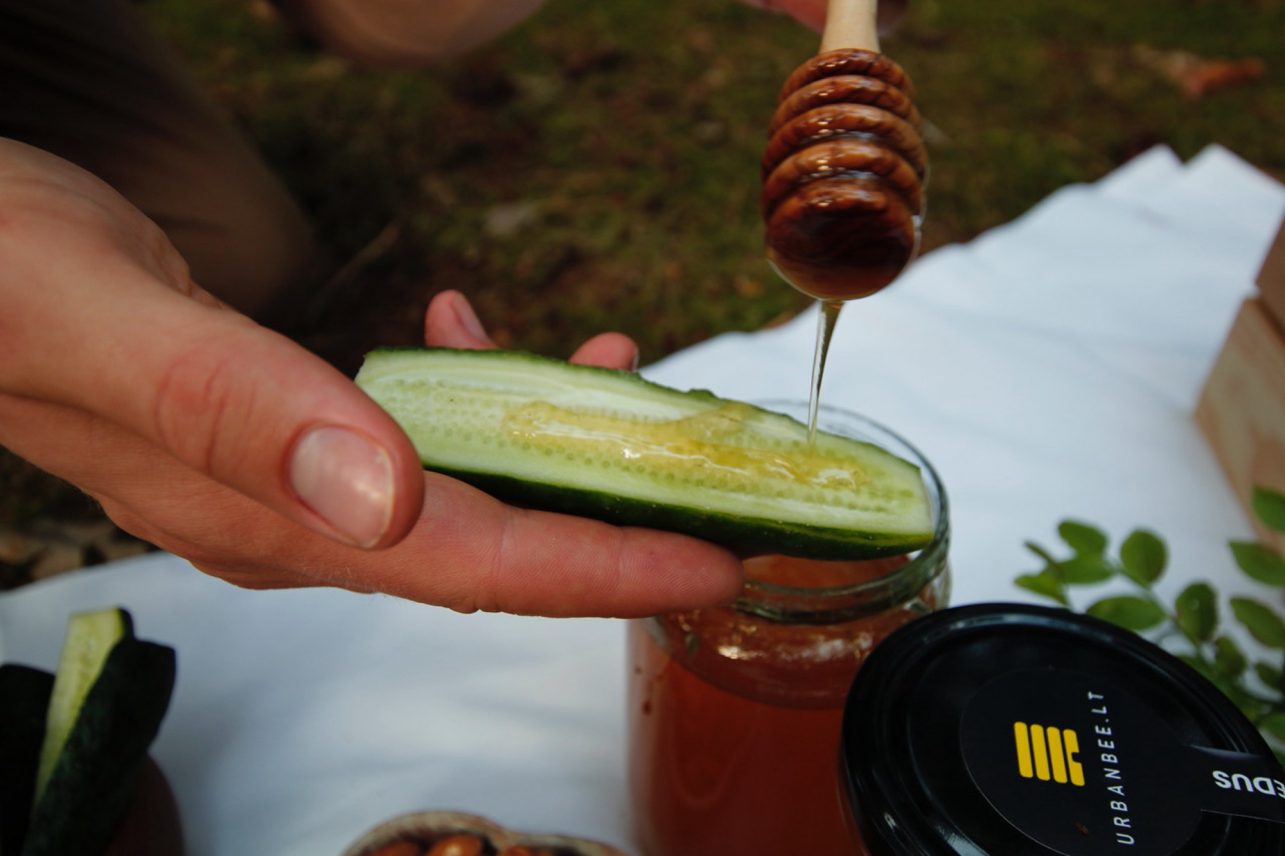
“Athletes often use bee bread in shakes as a natural source of protein. Bee bread reduces cholesterol. It can be simply sprinkled on salads, sandwiches, porridges, smoothies. This will give it a slightly more sophisticated taste. You can also use pollen – the primary product, it is suitable if a person cannot eat fermented food,” Paulius adds.
Before diving into Paulius’ favorite recipes, I asked what the bees’ favorite dish would be like. Paulius remembered how he trained a bee for a pizzeria advertisement in England, which is why I nicknamed him a bee whisperer in addition to beekeeper. “This memory came to mind immediately, so I think that the best combination for bees would be a pollen pizza with a linden honey cocktail.” Sounds like a great combination! And when we’re too lazy to bake a pizza, we can make each of our gourmand bees happy by installing drinking bowls, sprinkling woody or flowering plant seeds in our yards and gardens, and of course, avoiding the use of pesticides and herbicides. This will not only help the bees, but also our own health. You can also always have a few flower bombs in your pockets to brighten up the city, which I hope will eventually become the only bombs people drop.
Out of many recipes humming in his head, Paulius decided to share a few extremely universal and simple ones. He and his family have long since stopped using white sugar. They sweeten their meals with their own-produced honey. As he listed the recipes, I could only be glad that we were talking after a hearty lunch, but the very next day I ran to the orchard to pick apples and then listened to my stomach growling quietly while the honey pie was baking nicely in the oven.
Paulius’ crumble:
● Apples and / or pears (can be replaced with berries)
● Butter
● Flour
● Honey
● Salt
● Additionally: almond flakes, oatmeal, vanilla extract, lemon, cinnamon
Chop the fruits/berries, put them in a pot, add a splash of water, put a large spoonful of honey, a pinch of cinnamon, lemon peel and heat lightly until the fruits/berries release their juices and soften. While the pot is heating, you can make a crumbly dough: add butter and flour and knead until crumbs form. You can also add a little honey, then salt, mix in vanilla extract, almond flakes or oatmeal. Mix everything well. Pour the boiled fruit/berries and sprinkle the crumble on top of it and bake in the preheated oven at 180 °C for 30 minutes or until the top layer of the crumble will turn light golden. It can be served with ice cream, cream or just a spoonful of homemade sour cream.
Sweet and spicy sauce
● Chili pepper
● Garlic
● Oil
● Honey
Fry chili peppers in oil on a pan, add garlic. After frying and turning off the heat, add a spoonful of honey and mix. This is a topping suitable for tortillas, sandwiches, and steaks.
Teriyaki sauce
● Soy sauce
● Garlic
● Ginger
● Honey
Heat soy sauce, garlic and ginger on a pan. After sautéing and turning off the heat, add a spoonful of honey and mix. If it is used as a marinade, then you do not need to fry the ingredients, just mix them all well.
Paulius’ fiancée Rimantė’s dessert
● Yogurt
● Spanish sage seeds
● Honey
● Blueberries
Layer the available ingredients (yogurt, sage seeds, honey, berries). Keep for several hours until the seeds swell.
In these recipes, the honey is processed at high temperatures, so I wanted to know if it’s OK to heat the honey or should we avoid it? “Honey can be easily heated up to 40 degrees. Above 40 degrees, chemical substances begin to be released, but only over a long period of time, about 2-3 days. It is completely different if the honey is immediately placed at a temperature of 90 degrees or higher, because then we burn all the good properties of honey, but the effect of sweetness remains. You don’t have to be afraid of cooking with honey because it loses its properties, it’s just a great and healthy alternative to white sugar.”


